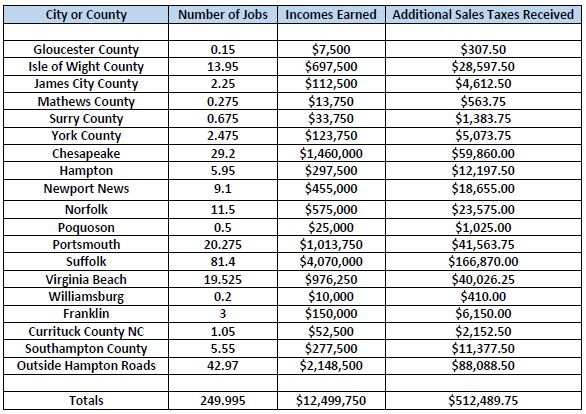The economies of 17 Virginia localities and one North Carolina locality in the Hampton Roads region are more inter-related than they were 10 years ago. Almost two-thirds (more than 65%) of all workers in the metropolitan statistical area commute to jobs outside the jurisdiction where they live — up from less than 60% in 2005, according to a new report, “Our Jobs Are Also Your Jobs,” published by the Hampton Roads Economic Development Alliance.
That fact has profound implications for economic development strategy, argue the report’s authors James V. Koch and Vinod Agarwal with Old Dominion University. Political leaders of Hampton Roads jurisdictions act as if “the only really good economic development project is the one that is located squarely inside their own city our county,” they write. What that assumption overlooks, however, is the extent to which the economic impact — and benefits — are diffused throughout the metropolitan economy.
Koch and Agarwal gave the hypothetical example of a new warehouse facility built in Suffolk to serve the growing cargo business flowing through the ports in Norfolk and Portsmouth. Suppose that warehouse employs 250 people averaging $50,000 annual pay (including managerial salaries but not including fringe benefits). Here is how they predict those jobs, income and sales tax revenues would be distributed geographically.
In this example, while Suffolk would enjoy the biggest impact, the benefits would be broadly distributed through the region. Suffolk residents would reap about one-third the jobs, income and sales tax revenues. Yet, to pick a different locality, the project also would create 20 jobs for Virginia Beach residents and generate $40,000 a year in additional sales tax revenues.
Moreover, the Suffolk warehouse would spend money on products and services from area businesses, which also would be distributed geographically.
“When more than 65 percent of individuals cross city and county lines to travel to their place of employment, it is inevitable that economic benefits will be widely diffused,” write Koch and Agarwal. “The moral to the story is that regional cooperation and regional economic development efforts make sense. … Parochial approaches to economic development are not likely to achieve great success — if success is interpreted to mean capturing the economic benefits that are generated by a new or expanded business. … The economic success of one city or county soon becomes another’s.”
Bacon’s bottom line: What applies to Hampton Roads applies to every other metropolitan region in Virginia. Nowhere in Virginia do political boundaries coincide with economic boundaries. From a regional perspective, economic development is best pursued as a regional enterprise.
Koch and Agarwal highlight an important insight, although they do overlook a critical facet of economic development that will not change without a dramatic re-write of Virginia’s tax code: The locality where a new warehouse, manufacturing plant or corporate facility locates captures 100% of the property tax revenue. Because property tax is the largest single source of local revenue in Virginia, local governments are highly motivated to see to it that a particular project lands within their boundaries. Unless subsidies are offered to attract the investment, such facilities are a big winner for the locality in question because business operations require little in the way of public services. Indeed, the fact that 2/3 of a company’s employees are located outside the jurisdiction means the locality in question is saddled with the cost of providing educational and other government services to only 1/3 of the workforce. Thus, ironically, the more economically interdependent the localities of a region are, the more local governments are incentivized to capture the tax benefits of bagging a corporate investment.
The only way to change that dynamic is to change the tax code to allow for (or require) the regional sharing of revenue from commercial and industrial property. And that will never happen because any change would create winners and losers, and the losers would fight like hell to thwart it.
But the Koch-Agarwal paper does make a sound argument for supporting regional economic development organizations like the Hampton Roads Economic Development Alliance. Fortunately, most Virginians get it, and a regional approach to economic development predominates in the Old Dominion.




